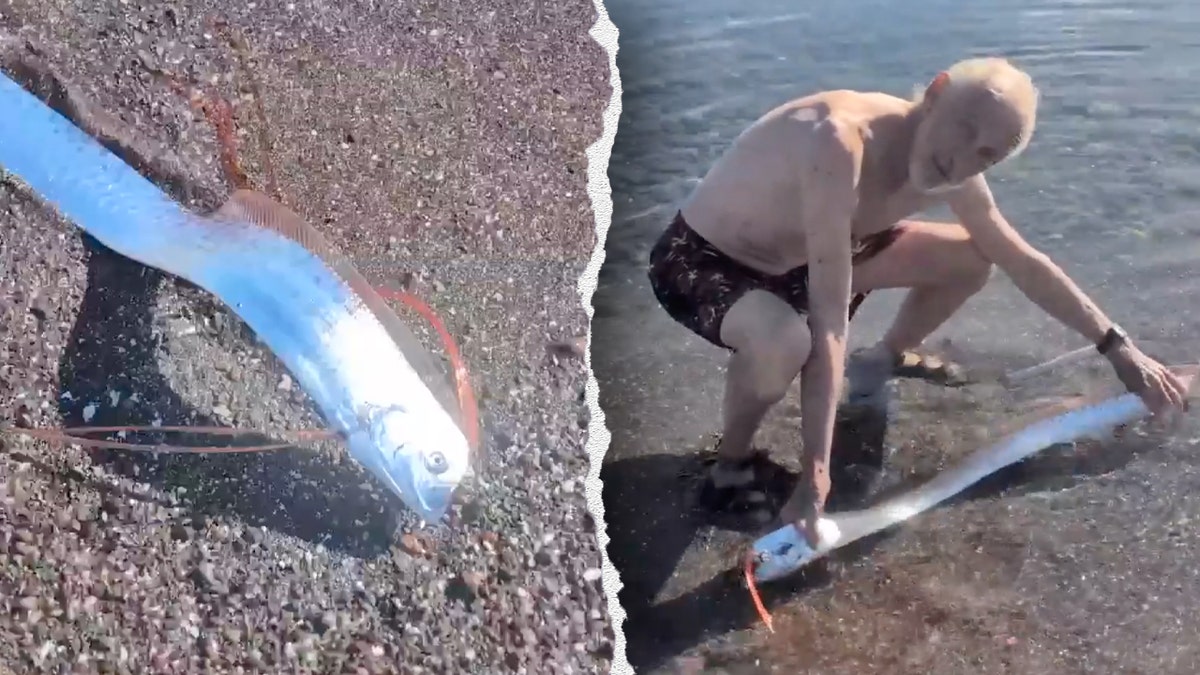
A Rare Encounter: Oarfish, the ‘Doomsday Fish,’ Surfaces in Shallow Mexican Waters
On a sun-kissed beach in Playa El Quemado, Baja California Sur, Mexico, a group of beachgoers stumbled upon an extraordinary sight that sent shivers down their spines. A silvery, iridescent oarfish, a creature typically found in the abyssal depths of the ocean, had inexplicably emerged in the shallow waters, its sleek body washing ashore during the broad daylight.
The majestic fish, captured on video by beachgoer Robert Hayes, swam straight towards the astonished group, its sharp head breaking the water’s surface by mere inches. "We redirected it three times out to the water, but it came back each time," Hayes recounted to Storyful.
As the flat-bodied fish lay stranded on the beach, outside its natural habitat, another individual in the video, recognizing the rare species, attempted to guide it back into the ocean. However, to their astonishment, the fish stubbornly returned to the shore. "This is amazing, it’s the smallest one [oarfish] I’ve ever seen," the man exclaimed in the video.
The Infamous ‘Doomsday Fish’: A Messenger of Ill Omen?
Oarfish, known in Japanese folklore as "ryugu no tsukai" (messenger from the Sea God’s palace), carry an ominous reputation as "doomsday fish." Superstitions abound, attributing their appearance near the surface or in shallow waters to forewarn of impending natural disasters, such as earthquakes or tsunamis.
According to the Ocean Conservancy, oarfish typically inhabit the great depths of the ocean, ranging from 650 feet to over 3,200 feet. Their presence in shallow waters is highly unusual and has baffled scientists for centuries.
Possible Reasons for Oarfish Beachings
In recent years, scientists have suggested that the increased spotting of oarfish off the coast may be linked to changes in ocean conditions, such as the El Niño and La Niña cycles. However, these correlations are not always evident.
As explained by Ben Frable, manager of the Scripps Oceanography Marine Vertebrate Collection, "Sometimes it may be linked to broader shifts such as the El Niño and La Niña cycle, but this is not always the case."
The Florida Museum postulates that oarfish are only sighted on the surface of the water or in shallow depths when they are injured or dying. This could explain the stranded fish encountered by the beachgoers in Mexico.
Physical Characteristics and Behavior of Oarfish
Oarfish are remarkable creatures, possessing unique physical attributes and behaviors. They can reach lengths of up to 36 feet, with a long, flat, and tapering body adorned with a silvery sheen. A prominent dorsal fin runs the length of their body, which they use for locomotion and maneuvering.
Their unusual, slightly concave profile features a toothless mouth, indicating their primary diet of krill and crustaceans, which they filter out of the water. In their natural habitat, oarfish spend time floating vertically in the water column, camouflaging themselves with their elaborate red first spines of their dorsal fin and pelvic fins.
Human Interaction and Conservation Efforts
The oarfish encountered in Mexico was fortunate to encounter a group of individuals who handled the situation with care and concern. In the video, the man who identified the fish aided its movement through the water, demonstrating a respectful and compassionate approach.
He expressed his intention to take the fish to a marine biologist for further examination if it had sustained any injuries. Such acts of responsible interaction are crucial for the conservation of these enigmatic creatures.
While oarfish are not considered endangered, their unique behavior and limited knowledge surrounding their population status warrant conservation efforts. Minimizing human disturbance, reducing pollution, and protecting their natural habitats are essential steps towards ensuring the survival of this fascinating species.
Conclusion
The appearance of an oarfish in shallow Mexican waters remains a captivating and somewhat enigmatic occurrence. Whether it was a harbinger of doom or a mere coincidence, the encounter serves as a stark reminder of the interconnectedness of life on Earth.
The increasing presence of these deep-sea creatures in shallower waters underscores the importance of ongoing research and conservation efforts. The preservation of our marine environments and their inhabitants is imperative for the well-being of both nature and humanity.
